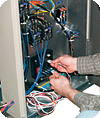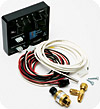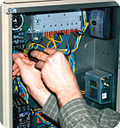
To activate the Smart Defrost Kit, the refrigeration
technician turns off the power, connects the sensors to the module, then turns
on the power. (Photos courtesy of Heatcraft Refrigeration.)
“A lot of times you’re turning on those heaters even when there isn’t as much frost on the coil,” he said. “If you were designing a system, you’d only want to defrost as often as necessary.”
On the other hand, if there are not enough defrosts, you get an iced coil, Kitchen said. “It accumulates too much ice, and it could damage the compressor due to floodback. Most likely you lose the box temperature because you’re basically losing the capacity of the evaporator.”

To activate the Smart Defrost Kit, the refrigeration tech
turns off the power, connects the sensors to the module, then turns on power.
BALANCING ACT
Based on the company’s research, 70-75 percent of defrosts that occur are unnecessary. Beacon II, the company’s controller that is installed in its own refrigeration products, skips up to 75 percent of defrosts, Kitchen said.The company’s new Smart Defrost Kit (SDK) skips up to 40-45 percent of programmed defrosts, depending on hours of operation and open-closed times. “If it needs the defrost, it will allow it. We’re only skipping what’s not necessary. You want to protect your product while skipping the unnecessary defrosts.”
The package, which is retrofitted onto existing systems, “builds a pretty sophisticated statistical model” based on measurements of suction pressure and temperature, outdoor ambient temperature, compressor on-off patterns, etc., “to determine what’s happening in the evaporator coil,” Kitchen said.
It works in conjunction with electromechanical time clocks to skip unnecessary defrosts on typical electric defrost commercial refrigeration systems, he explained. After familiarizing itself with the system, it evaluates frost accumulation on the evaporator and determines whether or not the accumulation is significant enough to allow a prescheduled defrost to take place.
“It takes measurements, computing what’s going on and determining whether or not there is frost on the coil. It uses a pretty sophisticated statistical method to do that, and it continuously educates itself. It learns and adapts to that particular application. It’s actually a form of artificial intelligence.”
The kit actually was part of the Beacon II, which can only be purchased with Heatcraft’s refrigeration systems. “We found out that one of the most desired features was the Smart Defrost,” Kitchen said. “We tucked out that feature and made it a stand-alone kit.”

During installation of the Smart Defrost Kit, the tech
installs the suction pressure transducer onto the Schrader fitting.
PROBLEM PREVENTION
For refrigeration service contractors, the defrost kit can head off some problems. “It can increase the life of the heaters, and they tend to be a pretty big failure item on a refrigeration system.“That’s an emergency call,” Kitchen said. “Usually when you find that out, it’s after you’ve got an iced-up coil and your box is at 75ºF.”
The contractor still programs the system for a worst-case scenario, Kitchen said. The system can’t initiate more defrosts than it’s set up for; if the system is requiring too many defrosts due to an operation problem, the kit won’t mask the problem. “All it can do is skip a predetermined defrost.”

The Smart Defrost Kit is applied to existing refrigeration
systems to initiate defrost sequences as needed, rather than on a timed
schedule.
Because the heaters will last longer, this also helps achieve better product life and with fewer service calls.
It’s a single device that can go on a very large or very small system, he said. One smart kit is installed per system; “it could be one condensing unit with multiple evaporators. For every timer there needs to be one smart defrost kit.”
The SDK is marketed through InterLink, a commercial refrigeration parts brand of Heatcraft Refrigeration Products LLC. For more information, visit www.interlinkparts.com.

The first step of the installation is to turn off the
refrigeration system and mount the SDK control module inside the electrical
panel.
Sidebar: Third-Party Testing on Smart Defrost
ATLANTA - Intertek, a third-party testing company, confirmed that InterLink’s Smart Defrost Kit™ (SDK), is cutting energy costs for contractors’ customers. Using technology that predicts frost accumulation, the SDK has been shown to reduce the number of unnecessary defrosts up to 44 percent for restaurants, convenience stores, small grocery stores, cold-storage facilities, and refrigerated warehouses.With the cooperation of a national restaurant chain in Stone Mountain, Ga., Intertek began its testing on Feb. 2, 2007, with the intent of validating that its SDK is capable of reducing the number of unnecessary defrost cycles and temperature fluctuations in a walk-in freezer. Baseline data were recorded for two weeks without the use of an SDK. Then the kit was installed and readings were measured and recorded for an additional two-week period, concluding on March 2, 2007.
The tests demonstrated a defrost skip rate of 44 percent at the test site, “indicating that comparable applications can expect similar results,” said Jim Kitchen, senior product manager for controls of Heatcraft Refrigeration Products LLC.
The restaurant chain used a Larkin low-profile evaporator installed inside an 8- by 6- by 6-foot box with three glass doors attached. The box temperature set point was 0ºF with a 10º differential control thermostat. A Larkin 3-1/2-hp condensing unit (powered with 230 vac) was located on the building’s roof, approximately 10 feet above the refrigerated space. The store operated with four scheduled defrosts per day.
The kit is available from authorized InterLink wholesalers and is recommended for electric defrost commercial refrigeration systems with three or more scheduled defrosts per day. It is certified for all HRP brands, the companies said.
Publication date:08/27/2007



